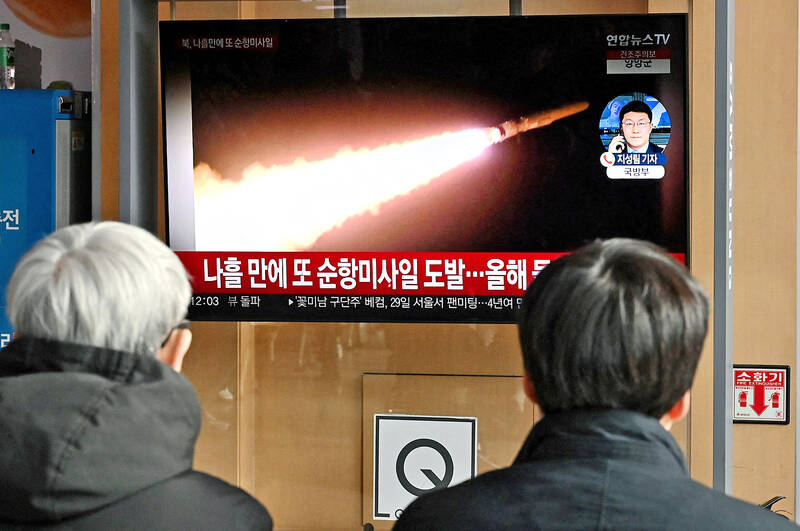The South Korean military yesterday said that North Korea fired several cruise missiles that flew over waters near a major military shipyard on the country’s eastern coast, extending a streak in weapons tests that are worsening tensions with the US, South Korea and Japan.
The launches followed a separate round of North Korean cruise missile tests last week and a Jan. 14 test-firing of the country’s first solid-fuel intermediate-range ballistic missile. Those tests reflect North Korean leader Kim Jong-un’s efforts to expand his arsenal of weapons designed to overwhelm missile defenses in South Korea and Japan and remote US targets in the Pacific, including Guam.
South Korean Joint Chiefs of Staff said they detected the missiles over waters near the North Korean port of Sinpo, where the North has a major shipyard building key naval vessels, including missile-firing submarines.

Photo: AFP
The South’s military did not immediately provide specific launch details, including the number of missiles fired, how far they flew and whether they were launched from land or naval assets.
Tensions on the Korean Peninsula have increased in recent months as Kim continues to accelerate his weapons development and issue provocative threats of nuclear conflict with the US and its Asian allies.
The US, South Korea and Japan in response have been expanding their combined military exercises, which Kim portrays as invasion rehearsals, and sharpening their deterrence strategies built around nuclear-capable US assets.
North Korea said its launches last week involved a new cruise missile called Pulhwasal-3-31 and described the test as part of regular efforts to develop its military. The North described that missile as “strategic,” implying a possible intent to arm it with nuclear weapons.
North Korea’s cruise missiles supplement the country’s huge lineup of ballistic missiles, including intercontinental ballistic missiles designed to reach the US mainland.
While North Korean cruise missile activities are not directly banned under UN sanctions, experts said those weapons potentially pose a serious threat to South Korea and Japan.
They are designed to fly like small airplanes and fly along landscapes where they could be harder to detect by radar.
Since 2021, North Korea has conducted at least 10 rounds of tests of what it described as long-range cruise missiles fired from both land and sea.

The CIA has a message for Chinese government officials worried about their place in Chinese President Xi Jinping’s (習近平) government: Come work with us. The agency released two Mandarin-language videos on social media on Thursday inviting disgruntled officials to contact the CIA. The recruitment videos posted on YouTube and X racked up more than 5 million views combined in their first day. The outreach comes as CIA Director John Ratcliffe has vowed to boost the agency’s use of intelligence from human sources and its focus on China, which has recently targeted US officials with its own espionage operations. The videos are “aimed at

STEADFAST FRIEND: The bills encourage increased Taiwan-US engagement and address China’s distortion of UN Resolution 2758 to isolate Taiwan internationally The Presidential Office yesterday thanked the US House of Representatives for unanimously passing two Taiwan-related bills highlighting its solid support for Taiwan’s democracy and global participation, and for deepening bilateral relations. One of the bills, the Taiwan Assurance Implementation Act, requires the US Department of State to periodically review its guidelines for engagement with Taiwan, and report to the US Congress on the guidelines and plans to lift self-imposed limitations on US-Taiwan engagement. The other bill is the Taiwan International Solidarity Act, which clarifies that UN Resolution 2758 does not address the issue of the representation of Taiwan or its people in

US Indo-Pacific Commander Admiral Samuel Paparo on Friday expressed concern over the rate at which China is diversifying its military exercises, the Financial Times (FT) reported on Saturday. “The rates of change on the depth and breadth of their exercises is the one non-linear effect that I’ve seen in the last year that wakes me up at night or keeps me up at night,” Paparo was quoted by FT as saying while attending the annual Sedona Forum at the McCain Institute in Arizona. Paparo also expressed concern over the speed with which China was expanding its military. While the US

SHIFT: Taiwan’s better-than-expected first-quarter GDP and signs of weakness in the US have driven global capital back to emerging markets, the central bank head said The central bank yesterday blamed market speculation for the steep rise in the local currency, and urged exporters and financial institutions to stay calm and stop panic sell-offs to avoid hurting their own profitability. The nation’s top monetary policymaker said that it would step in, if necessary, to maintain order and stability in the foreign exchange market. The remarks came as the NT dollar yesterday closed up NT$0.919 to NT$30.145 against the US dollar in Taipei trading, after rising as high as NT$29.59 in intraday trading. The local currency has surged 5.85 percent against the greenback over the past two sessions, central